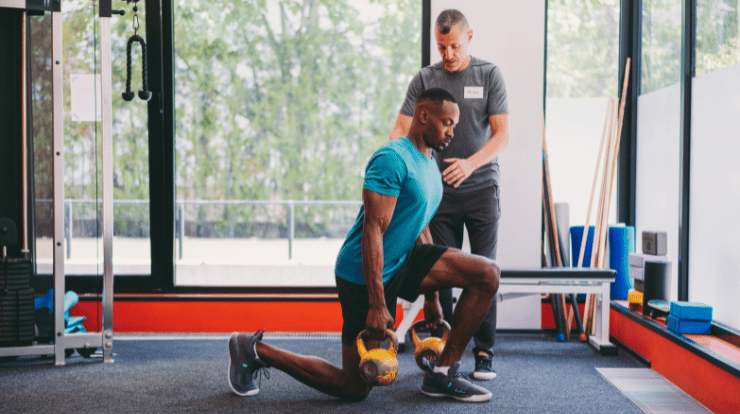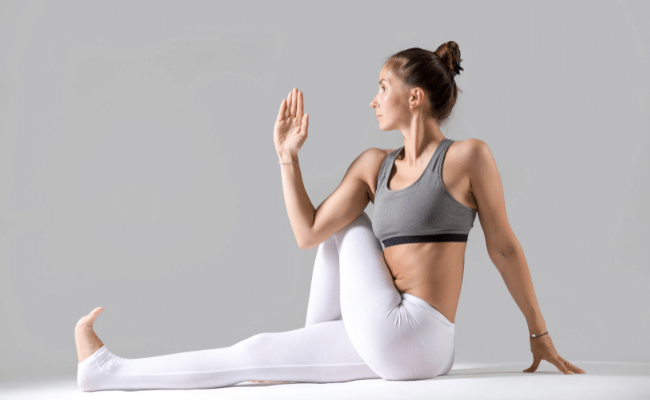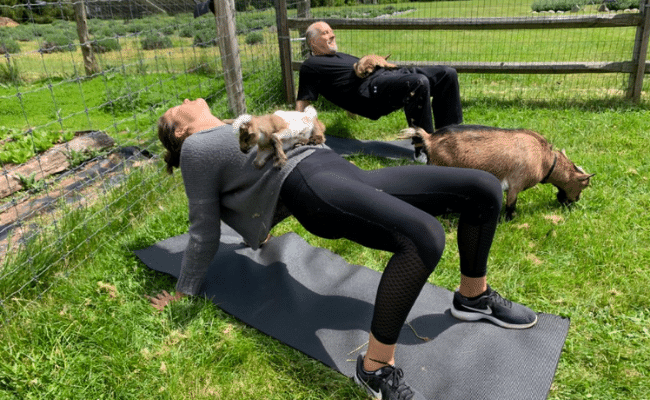
Stretching Exercise Similar to yoga helps our muscles recover faster after activity. A new study has shown that stretching exercises similar to yoga can actually help muscles recover faster after activity. Whereas conventional wisdom holds that it’s best to rest sore or tired muscles, a small but growing body of research is uncovering unexpected benefits of gentle muscle stretches and massages, known as mechanotherapy.
The findings suggest going easy on muscles — instead of letting them rest after they’ve been worked hard — may actually speed recovery from strains and sprains. “The idea here is that you have these guys who are exercised for 20 minutes or so to exhaustion,” explained physiotherapist Megan Gillan. who led the new research at the University of British Columbia. “It’s not just your legs that are tired. Your whole body is tired.”
The study showed that a 15-minute session of gentle muscle stretches and massages after exercise helped improve the recovery of leg muscles. “We had people do either experimental, which was yoga-like stretching exercises, or they did nothing,” she said. “They were put in what we call an isometric stretch position, where their legs were extended but not moving at all and left there for about 15 minutes.
Is Pilates Similar to yoga?
Pilates has been compared to yoga. Do both Pilates exercises and yoga pose increase core strength? Pilates and Yoga have become synonymous with each other. A lot of people think that Pilates is similar to yoga, but they are not. They are different practices that share some common elements such as breathing patterns, controlled movements, and emphasis on mindfulness. This may be why some people confuse a Pilates workout for a yoga class or vice versa. But while these two disciplines share some similarities,
They also differ in many ways:
- What You Wear
- How Do They Begin
- What You Do
- Duration of the Workout
- Who’s Leading
1) What You Wear:
In most physical activities you get dressed accordingly depending on the activity; whether it is running, biking, or swimming; you will wear appropriate attire. However, there is a big discrepancy when it comes to getting ready for a Pilates workout and yoga class. When studying the two physical activities, you will notice that while practicing yoga you can wear loose-fitting clothes as long as they do not restrict your movements or range of motion.
You can also wear shorts if you are doing a Bikram Yoga session (hot yoga). However, Pilate’s clothing is more structured and specific; there’s an appropriate way to dress for each exercise. A good example is the Reformer where tight-fitting garments are required. And remember, no jewelry should be worn during workouts in any discipline even though they seem very casual on paper!
2) How Do They Begin:
What does your typical day look like before going to a Pilates session? Or a yoga class for that matter? Have you come across two individuals who prepare differently before their respective workout sessions of either Pilates or yoga? When it comes to preparing for your workout, if you are doing yoga you will probably start by practicing a few warm-up poses and breathing exercises. Then, when the instructor tells you so, you can proceed with whichever type of yoga pose is next in the sequence.
However, unlike yoga (where it’s not mandatory to have any equipment), when doing Pilates, we highly recommend using some equipment such as resistance bands or even dumbbells because they increase your range of motion and help tone certain muscles with better results than if done without them. Also, another difference is that you will have a Pilates instructor guiding you step-by-step on how to do each exercise and some modifications that can be done in case there are any beginner issues.
3) What You Do:
The main core difference between practicing yoga versus Pilates is that with yoga, you practice poses or positions. however, when doing Pilates exercises there are no static poses similar to yoga; rather each exercise focuses on specific muscle groups with movements mostly done from the center outwards – meaning starts from the core and moves outwards to your extremities.
With yoga, you usually have different styles of poses (asanas) that include various physical postures or positions. however, with Pilates, there are only five core movements that focus on building a solid foundation for both strength and flexibility in the body following what Joseph Pilates started 90 years ago.
These five basic exercises are technically called “Contrology” movements which consist of hundreds of exercises all done with an emphasis on proper breathing patterns and alignment to help strengthen the mind-body connection so that we can improve our quality of movement in everything we do throughout our day – from playing a sport to walking up and down stairs or even just simply picking items up off the floor.
4) Duration of the Workout:
Depending on which discipline you choose to practice (whether it is yoga or Pilates), your time allotment for exercising could be different. In most cases, with a traditional yoga class, you spend anywhere from 1 hour to an hour and a half; however, this depends on what type of yoga class suits your needs.
For example, if you’re more into hot yoga (Bikram Yoga) then expect a small break between each sequence otherwise it may last up to 2 hours without breaks! Pilates exercise classes, typically last from 30 to 60 minutes (varies depending on the studio). Depending on your fitness level, you can either go through a beginner or advanced class. But in most Pilates studios the average time is around 45 minutes.
5) Who’s Leading:
When it comes to yoga instructors and their credentials, they have to meet certain requirements in order to teach at a given studio which includes having their own teaching certification. In some cases, yoga teachers are required to take additional courses before they can start instructing others.
On the other hand, Pilate’s instructors do not need any formal training; all that is needed is for them to be certified by an international Pilates organization such as IDEA Fitness or Polestar Pilates UK. They also have to take an exam and attend a workshop to ensure they are up-to-date with new Pilate’s methods.
If you are curious about who is the current President of the International Association of Pilates (IAP), it’s Michelle Brock whose expertise lies in her ability to look at what today’s body needs as she develops effective contemporary programs that can be performed by clients in a safe way which addresses individual goals.
Activities that are Similar to yoga:
- Gymnastics
- Weight Lifting
- Running
- Martial Arts & Kickboxing
- Hiking
- Gym Circuit
- Swimming
- Tennis & Volleyball
- Cycling

1) Gymnastics:
this is my favorite, even though you don’t see any 90-degree angle or touching your toes here, the variety of poses in gymnastics give it a similar feel to yoga when done right. I have been doing gymnastics for 4 years now and I can see so many similarities between the two activities. It is more Endurance based as well but my point is that one can get a great workout without *touching their toes or bending over backward*
2) Weight Lifting:
THIS IS A MUST!!!!!! So many people say they can’t do yoga because of injury, but let me tell yak if you are trying to get stronger or change your silhouette weight lifting will definitely help – especially CrossFit-style weight lifts. You get to lift really heavy and do the same poses as yoga but obviously with a more strength/muscle-based version (looking at your scorpion pose!)
3) Running:
This is a great way to build endurance – I know running 6-8 miles every day doesn’t sound like fun for most people, but if you can teach yourself how to enjoy the process of running then it will be easier for you to practice Yoga or any other form of exercise that will help you sculpt your body in ways no one else can ever achieve!
4) Martial Arts & Kickboxing:
If you are into these types of activities already, why not incorporate them into your routine? These activities would serve as HIIT training on separate days of the week.
5) Hiking:
I know this may seem like a boring activity but if you haven’t tried it yet, try it! Yoga is great for your flexibility so hiking can be beneficial to your yoga practice as well. not to mention it’s great for cardio too – the more you hike the more capable and better shape your legs will become!!
6) Gym Circuit:
Maybe instead of doing regular aerobics or cardio outside of the gym where they are (hopefully) air-conditioned, you do circuit training inside with weights and treadmills- This can help build endurance throughout your body while also building muscle at the same time. An example could look like 3 sets of 5 pushups, 10 burpees, 40 mountain climbers with 1 min rest in between each set. You can do this anywhere and it’s something that you could build up to where it would be a more intense workout than anything you’ve ever done before – get creative!
7) Swimming:
I’m not sure why swimming is so low on the list because personally I think it’s a great form of exercise and it is similar to yoga. You use all your body parts, unlike running when you are working just your lower half (legs), or weight lifting when you are using only your arms and upper body. well, swimming hits all parts of the body!!! It also builds endurance as well as muscle tone in one go which makes it extremely efficient!
8) Tennis & Volleyball:
These activities are very similar to yoga because of their fluid motion – both looking at how you move continuously across the court when playing tennis and the constant movement in volleyball when jumping over the net with teammates. The only downside here is that you don’t get the same kind of muscle toning and endurance that you would if it were an actual yoga class!
9) Cycling:
I know cycling has been around longer than any other exercise on this list, but I think it’s extremely underrated! It can be done indoors or out and with the right bike (like one that simulates old school cycling) you can get a great workout in without putting any additional pressure on your joints. Cycling has many benefits: it helps to improve flexibility and joint mobility, improves cardiovascular endurance, burns calories, builds strength as well as muscle toning throughout your entire body proportionate to the resistance levels that you set on your bike.
Is barre Similar to yoga?
I’ve been asked this question a lot lately. “Is barre similar to yoga?” I can see how you may think it is. They both involve using your own body weight as resistance, they both promote flexibility and strength development, they’re both practiced in an athletic position. But the comparison stops there. In fact, barre classes are more like any other ballet or pilates class you have ever taken than a yoga class! The format of the class and the prep work done before each exercise means that barre training is actually much closer to pilates than yoga—and certainly moves farther away from yoga than pilates does!
Barre classes are structured much more like a conventional aerobics class with a warm-up, strength training, and a cool down than they are like other forms of yoga. In fact, barre instructors rarely include poses that resemble any recognizable yoga pose—no child’s pose, tree pose, or warrior II here! Likewise, the use of props is nonexistent in a barre class.
The main difference between barre and yoga is the intention behind each practice.
Yoga focuses on staying present in your body while moving through the poses. The breathing is typically longer and deeper than you think it would be during such a stretching class, which helps with relaxation. You can take classes with instructors who encourage this or that interpretation of more philosophical/spiritual ideas about life and existence but at its essence, yoga’s focus is on increasing awareness of how you move your body so that you can use it better.
It also works to balance out your left and right sides (an imbalance can predispose you to injury), strengthen abdominal muscles (which supports good posture), increase flexibility, improve
Is yoga similar to yoga mediation?
yes, yoga is similar to yoga mediation because when we do yoga, it makes us clear our minds. So, this way yoga and yoga mediation are similar. When we start doing yoga, then automatically our mind gets connected to nature and other people. Then more we become calm and peaceful in daily life. But only by doing physical exercises or postures (asana), we cannot achieve mental peace, as there is a difference between body & mind.
The body is like a machine but the mind can control the body and you can use your mind for positivity or negativity too. The mind controls your thoughts so it will determine what kind of person you would be with positive thinking all the time or negative thinking both at the workplace or home with family? So, yoga is not just about physical exercise but it also helps to control your mind and clarity of mind. By maintaining a clear mind, then you can focus on whatever you want to do in your life and get success by using positive thoughts all the time.
When we meditate, it is not necessary to do physical exercises or yoga postures like standing with legs open, arms crossed at chest level, and looking up towards the sky (refer to the image below) and that will make you feel peaceful at the start of your meditation session.
It does so because when you are doing such asanas then automatically our mind gets cleared from all the tension from the workplace or home matters etc. So that is why when you need some time where your mind should be free from any kind of thoughts, then it is important to start meditating.

What yoga is similar to Bikram?
Yes, Bikram is similar to yoga. Many of the poses are similar to Bikram (even though Bikram yoga was created before Bikram). It’s a physical practice usually done in a heated environment. It is popularized by celebrities such as Gwyneth Paltrow, Madonna, and Sting among others.
It also shares some similarities with Vinyasa Flow, another form of Hatha Yoga where classes are fast-paced with lots of movement between postures. It is practiced in a heated environment, with some poses held for longer than usual.






